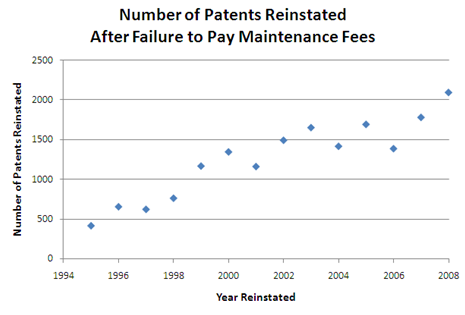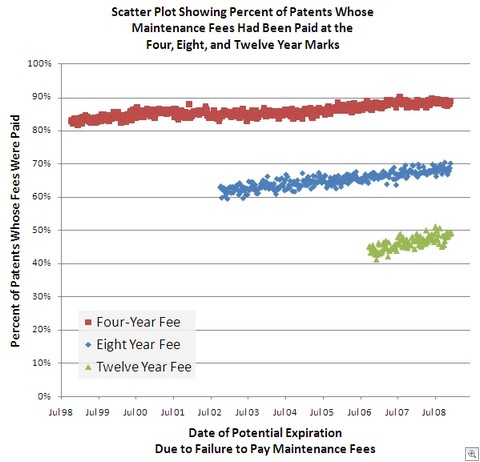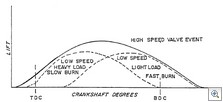IGT v. Aristocrat Tech of Australia (on petition for certiorari)
Every year, the PTO revives hundreds of unintentionally abandoned patent applications, and about half of those eventually issue as patents (not counting continuations and other descendants).
In the IGT case, the gaming-manufacturer was sued for allegedly infringing two of Aristrocrat's slot-machine patents. The first patent stemmed from an Australian provisional application that was followed by an international PCT filing. At the national stage in the US, the applicant missed the filing deadline but was able to convince the PTO to revive the application as unintentionally abandoned. The second patent is a continuation from the first.
In court, IGT has argued the revival was improper and thus, that the patents are invalid. IGT reasoned (and the district court agreed) that the revival was improper because the PTO lacked authority to revive national stage applications that were unintentionally filed late. Rather, the statute arguably only allows revival of applications upon proof that the tardiness was unavoidable.
Without determining the proper scope of the PTO's revival authority, the Federal Circuit rejected IGT's argument - holding that improper revival is not a "cognizable defense" to patent infringement and reminding defendants that a patent is not invalid simply because the PTO erred in issuing the patent.
Enumerated Defenses in Litigation: Section 282 of the Patent Act defines the defenses available against charges of patent infringement. These enumerated defenses include:
- Noninfringement …,
- Invalidity of the patent or any claim in suit on any ground specified in part II of this title as a condition for patentability,
- Invalidity of the patent or any claim in suit for failure to comply with any requirement of sections 112 or 251 of this title.
- Any other fact or act made a defense by this title.
In its analysis, the Federal Circuit found that improper revival did not fall within any of the four categories of defenses - and thus cannot be raised as a litigation defense. The case implicitly calls into question other traditional defenses such as nonstatutory double patenting, improper inventorship. IGT argues that the decision also implies that a defendant could not challenge a patent based on its expiration due to failure to pay maintenance fees. Of course, a defendant should have some mechanism for challenging an improperly revived patent - either through the courts or a post-grant procedure at the PTO. Under the Federal Circuit's rule, however, a typical defendant would have no recourse. (Two potential avenues could be (1) inequitable conduct in the revival and (2) trigger an interference.)
Leaving the PTO's revival grant's unchallengeable is particularly troublesome because of the serious lack of transparency in the petitions office. Pre-grant revivals are tucked away in individual prosecution file wrappers and cannot be searched in any public database. Thus, the public is left without any check on the system at either the micro or macro level.
Petition for Certiorari: IGT has petitioned the Supreme Court for a writ of certiorari and has garnered the support of the group of usual defendants (Cisco, Dell, Google, Microsoft, etc.) with the simple question:
Whether a patent infringement defendant may assert as a defense the fact that the patent resulted from an abandoned application that was not revived according to the requirements prescribed by Congress.
In several ways, this cases parallels the other recent Supreme Court patent cases such as KSR, eBay, and MedImmune. At least as history tells the story, each of those cases began with a rigid rule created by the Federal Circuit to favor patent holders. In each case, the Supreme Court softened the rule to add flexibility in a way that favors the defendants. In KSR, the rigid TSM test for applying multiple references during obviousness analysis was relaxed. In eBay, the rule strongly favoring injunctive relief was relaxed. And, in MedImmune, the rule setting a reasonable apprehension of a lawsuit as a condition precedent to a declaratory judgment action was also relaxed. In the IGT case at hand, the Supreme Court has the opportunity to tear down another rigid application of the law and open a new avenue for defendants to challenge a patent holder's rights.
Invalidity of the patent or any claim: Although slightly off-topic, I am intrigued by the wording of Section 282, which creates the defense of "invalidity of the patent or any claim." (Emphasis added). Ordinary validity issues focus on individual claims. Is the claim anticipated or obvious? Is the claim definite, fully described, and enabled, and does it properly claim patentable subject matter? The general focus on the validity of claims begs the question of what we mean by "invalidity of the patent." IGT's theory of invalidity based on improper revival is bolstered here because it would breathe meaning into the statutory invalid "patent."
Aristocrat's opposition and any amici in opposition are due April 22.
Briefs:
Related Posts:
- Dennis Crouch, Erroneous Revival by PTO is not a Cognizable Defense in an Infringement Action, Patently-O (Sept. 22, 2008)
- Dennis Crouch, CAFC to Decide Important Revival Case: Aristocrat v. IGT, Patently-O (Dec. 12, 2007)
- Dennis Crouch, No Revival For "Unintentional" Missed National Stage Filing Date (Delay Must Be Unavoidable), Patently-O (Jul. 26, 2007)
- Dennis Crouch, Reviving Unintentionally Abandoned Patent Applications, Patently-O (Feb. 26, 2008)
- Dennis Crouch, IGT Petitions for En Banc Rehearing: Asking Court to Allow Invalidity Defense for “Improper Revival”, Patently-O (Oct. 7, 2008)
- Dennis Crouch, Reinstating Patents After Failure to Pay Maintenance Fee, Patently-O (Feb. 26, 2009)
- I mentioned above that improper revival could be challenged in the course of an interference. Chico Gholz pointed me to his 2009 IP Today article addressing the issue: Aristocrat V. IGT: Another Reason Why Provoking An Interference May Be Preferable To Defending An Infringement Action. Of course, as one comment already indicates, interferences are severely time-limited.


